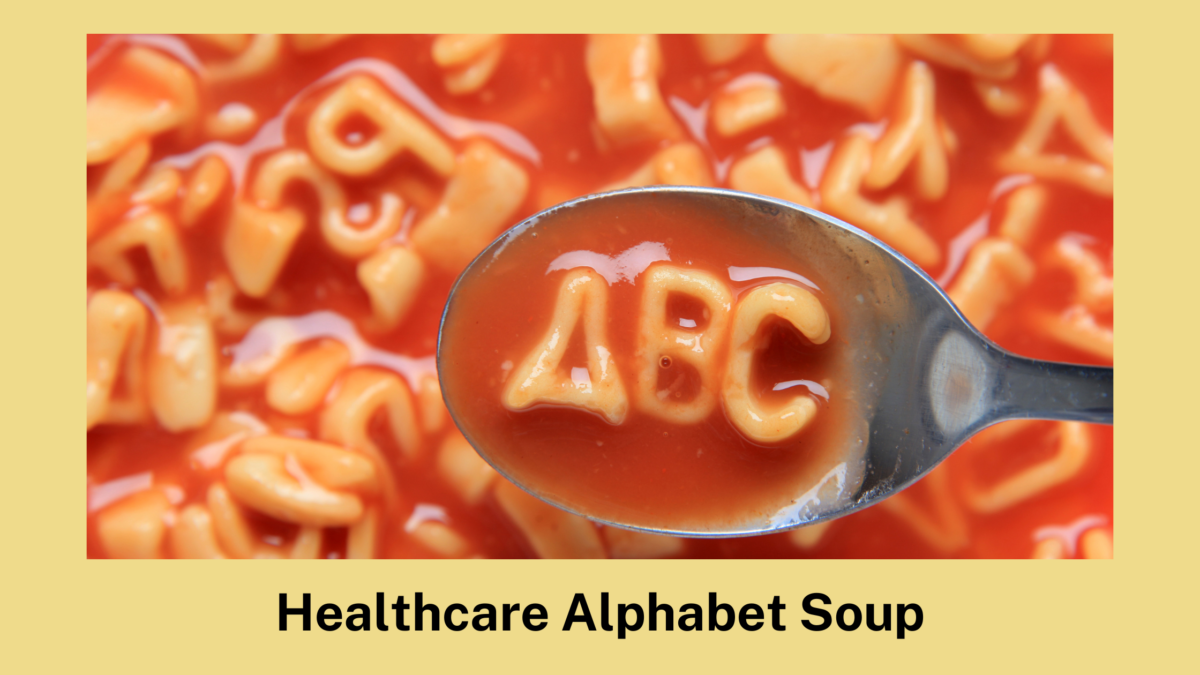Kylie Dugan, SPT – Texas State University Doctorate of Physical Therapy Class of 2023
Healthcare is a field that is especially notorious for having many acronyms and initials that can often be confusing. You may hear your physical therapist (PT) or another healthcare provider referring to another profession, certified specialist, or treatment technique by initials. We thought it might be useful to explain some of the most common acronyms heard in the clinic lately:
- Occupational Therapist (OT): The main role of occupational therapy is to make sure that patients are able to successfully complete activities of daily living (ADLs), which include tasks like bathing, eating, and getting dressed.1 OTs can offer help with strategies and training for how to physically accomplish tasks. For instance, an OT might suggest built-up grips on a fork or spoon for someone with arthritis. Or an OT might teach a patient how to strategize/mentally plan to accomplish tasks, such as breaking down the steps of food preparation for someone on the autism spectrum to allow them to live independently. Currently, OTs must complete a Master’s-level degree program, take a state licensing board exam, and apply for professional licensure in order to practice occupational therapy in the state of Texas.
- Certified Hand Therapist (CHT): CHTs can be OTs or PTs who have undergone additional post-graduate training and education to specialize in working with the hand.2 CHTs have accomplished over 4000 direct clinical hours in the specialty area of hand therapy. Certified Hand Therapists also are likely to assess the elbow and shoulder to determine how these joints are contributing to hand function and vice versa. Patients are most likely to be referred to a CHT after a hand surgery or hand injury.
- Lymphedema/Lymph Management Specialists (CLTs): These are clinicians who specialize in managing swelling.3 Certified Lymphedema Specialists can have backgrounds in nursing, PT, massage therapy, and more! Their interventions often include manual lymphatic drainage (MLD), which is a specialized soft tissue technique that helps lymph (the fluid in swelling) return to the heart to be recycled throughout the body.
- Pelvic Health PT Specialist: These PTs have undergone additional training and certification to specialize in caring for patients who have difficulty with bowel and bladder incontinence or retention, pre- or postpartum care, pain with sexual activity, chronic pelvic pain, and more.4 These therapists work internally and/or externally to help coordinate the complex musculature of the pelvic floor to allow patients to improve pelvic function.
- Wound Management Specialist: While you may have seen wound care in a hospital setting for a post-surgical or traumatic wound, this service is also available in an outpatient setting! Wound Management Specialist clinicians can be PTs or nurses who specialize in helping wounds heal as quickly as possible while minimizing the risk of infection or other complications.
- Orthopedic Certified Specialist (OCS): An OCS-certified therapist has completed post-graduate education and training in orthopedics – an area of physical therapy practice that focuses on injuries, disorders, and/or disease processes involving bones, joints and muscles and related neurovascular systems. Practitioners who have earned an OCS designation have also successfully passed a national board examination process in this specialty area.
- Manual Therapist (MTC & others): A manual therapist has completed post-graduate coursework and typically also residency training with a mentor in the specialty area on physical therapy that involves hands-on treatment. Joint mobilization / manipulation, mobilization of soft tissues (muscles, tendons, fascia), and neural mobilization (nerve tissue manipulation) are some examples of techniques that are the specialty of a Manual Therapist.
- Fellow of the American Academy of Orthopedic Manual Physical Therapists (FAAOMPT): A fellowship-trained physical therapist is a nationally recognized expert in musculoskeletal care (orthopedics) and in manual therapy (hands-on treatment). These practitioners have completed extensive post-graduate residency programs and clinical mentorships that focus on advanced clinical reasoning and clinical decision making skills and on the application of current, research-supported “best practice” strategies for patient care.
We hope that these explanations can help to make sense of some of the “alphabet soup” that you might encounter during the course of your experiences with the healthcare system!
References:
- About Occupational Therapy. Aota.org. https://www.aota.org/about/for-the-media/about-occupational-therapy.
- What is Hand Therapy? Find a Certified Hand Therapist (CHT). https://www.htcc.org/.
- Lymphedema: Causes, symptoms, physical therapy treatment. APTA Pelvic Health. https://aptapelvichealth.org/2019/05/25/lymphedema-causes-symptoms-physical-therapy-treatment/.
- Public Awareness & Education. APTA Pelvic Health. https://aptapelvichealth.org/patienteducation/.

